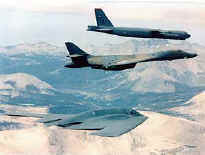After the US Air Force retired 36 B-1B Lancer bombers in 2002, Congress ordered 23 returned to service. The US Air Force has reluctantly agreed to return seven, but claims the others have been too cannibalized. The Air Force retired the bombers to save money in order to afford more fighter aircraft, yet has no plans to add new bombers to the force. The 12-10-01 issue of Aviation Week presented some interesting figures.
| Aircraft | Cost per Flight Hour | Cost per bomb dropped 500 miles from base |
| F-16 | $9,300 | (2) $6380 each |
| F-15E | $14,300 | (4) $9220 each |
| B-52 | $23,100 | (12) $5120 each |
| B-1 | $32,700 | (24) $3690 each |
| B-2 | $89,300 | (16) $7540 each |
The article points out that the cost for F-16s
and F-15s rise $2000-$3000 per bomb at ranges over 1000 miles because they
require tanker support. The B-2 costs are high due to the
need to repair its composite body after each mission. The new F-22 can carry just half the bomb
load of the F-15E, so the rush to scrap B-1s is a mystery. Yes,
their cost per flight hour is twice that of fighters, but they carry many times
more payload.
The Air Force should bring "cannibalized" B-1s back into service as bomber escorts for electronic warfare and even fighter roles. There is plenty of room aboard the B-1 to operate the EA-6B electronic warfare system used by that four man crew. The USAF is unlikely to face serious air combat in the coming years, yet bombers are defenseless against any type of enemy fighter which may appear. F-15s and F-22s haven't the range to escort bombers on long-range missions, yet there is no reason why a B-1 with the proper fire control radar cannot launch long range AMRAAM air-to-air missiles should an enemy fighter appear. Perhaps the F-22's advanced radar and fire control systems can be fitted into B-1s to become EF-1 "Dancers".
A large EF-1 would lose in a dogfight, however it could keep fighters busy while the bomber formation escapes. In addition to AMRAAMs and HARM anti-radiation missiles, an EF-1 could carry TURDs, to destroy pursuing enemy aircraft and missiles, even those fired from the ground. It would also have plenty of room for towed decoys now used by some fighters to deceive missiles. Yet another role for Dancers could be Bomb Damage Assessment (BDA). Normally, a bomber formation would be escorted by two EF-1s, one forward and one trailing several miles behind. They could carry the new ATARS reconnaissance pods to photograph bomb strikes and provide an immediate "before and after" picture. Even if two dozen B-1s have been cannibalized for old parts from their bomber systems, EF-1s would use newer systems needed for escorting bombers.
Yet another role for B-1s is dropping paratroopers. Fighters haven't the range to escort C-17 transports on long-range missions, which is important if paratroopers will be dropped. Some B-1s can become C-1s for use by the Special Operations Command. A long-range supersonic low flying C-1 cargo aircraft would be ideal for dropping and resupplying special ops personnel. The B-1 is an excellent aircraft with many years of service life remaining. It's time for the Air Force to think outside the box and bring all the B-1s back into service for varied missions.
Carlton Meyer editorG2mil@Gmail.com
©2004 www.G2mil.com